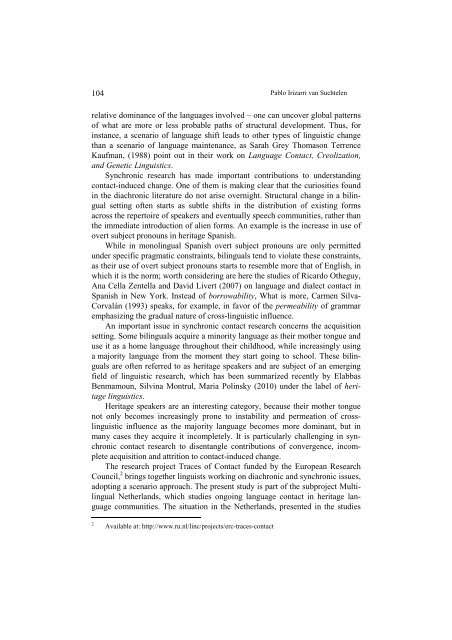s - Wyższa SzkoÅa Filologiczna we WrocÅawiu
s - Wyższa SzkoÅa Filologiczna we WrocÅawiu
s - Wyższa SzkoÅa Filologiczna we WrocÅawiu
Create successful ePaper yourself
Turn your PDF publications into a flip-book with our unique Google optimized e-Paper software.
104<br />
Pablo Irizarri van Suchtelen<br />
relative dominance of the languages involved – one can uncover global patterns<br />
of what are more or less probable paths of structural development. Thus, for<br />
instance, a scenario of language shift leads to other types of linguistic change<br />
than a scenario of language maintenance, as Sarah Grey Thomason Terrence<br />
Kaufman, (1988) point out in their work on Language Contact, Creolization,<br />
and Genetic Linguistics.<br />
Synchronic research has made important contributions to understanding<br />
contact-induced change. One of them is making clear that the curiosities found<br />
in the diachronic literature do not arise overnight. Structural change in a bilingual<br />
setting often starts as subtle shifts in the distribution of existing forms<br />
across the repertoire of speakers and eventually speech communities, rather than<br />
the immediate introduction of alien forms. An example is the increase in use of<br />
overt subject pronouns in heritage Spanish.<br />
While in monolingual Spanish overt subject pronouns are only permitted<br />
under specific pragmatic constraints, bilinguals tend to violate these constraints,<br />
as their use of overt subject pronouns starts to resemble more that of English, in<br />
which it is the norm; worth considering are here the studies of Ricardo Otheguy,<br />
Ana Cella Zentella and David Livert (2007) on language and dialect contact in<br />
Spanish in New York. Instead of borrowability, What is more, Carmen Silva-<br />
Corvalán (1993) speaks, for example, in favor of the permeability of grammar<br />
emphasizing the gradual nature of cross-linguistic influence.<br />
An important issue in synchronic contact research concerns the acquisition<br />
setting. Some bilinguals acquire a minority language as their mother tongue and<br />
use it as a home language throughout their childhood, while increasingly using<br />
a majority language from the moment they start going to school. These bilinguals<br />
are often referred to as heritage speakers and are subject of an emerging<br />
field of linguistic research, which has been summarized recently by Elabbas<br />
Benmamoun, Silvina Montrul, Maria Polinsky (2010) under the label of heritage<br />
linguistics.<br />
Heritage speakers are an interesting category, because their mother tongue<br />
not only becomes increasingly prone to instability and permeation of crosslinguistic<br />
influence as the majority language becomes more dominant, but in<br />
many cases they acquire it incompletely. It is particularly challenging in synchronic<br />
contact research to disentangle contributions of convergence, incomplete<br />
acquisition and attrition to contact-induced change.<br />
The research project Traces of Contact funded by the European Research<br />
Council, 2 brings together linguists working on diachronic and synchronic issues,<br />
adopting a scenario approach. The present study is part of the subproject Multilingual<br />
Netherlands, which studies ongoing language contact in heritage language<br />
communities. The situation in the Netherlands, presented in the studies<br />
2<br />
Available at: http://www.ru.nl/linc/projects/erc-traces-contact
















